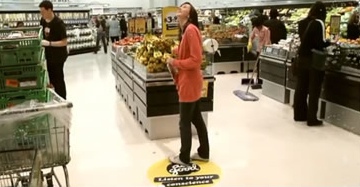 As the world is changing at ever faster rates, business leaders can no longer afford to be missing out on the exciting opportunities that new technologies have to offer. Consumers are craving for real experiences and understanding their preferences becomes paramount to stay ahead of the game.
As the world is changing at ever faster rates, business leaders can no longer afford to be missing out on the exciting opportunities that new technologies have to offer. Consumers are craving for real experiences and understanding their preferences becomes paramount to stay ahead of the game.
Whilst new technologies make our world more connected and personalised, it also opens up vast opportunities for reaching consumers with some engaging brand experiences. This year, some of the emerging trends are connected to mobile and audio technologies, facial and gesture recognition, and other content creation platforms that are redefining consumer behaviour and changing attitudes.
Here at Hotcow we have been seeing some great uses of innovative technologies such as digital signage, multi-touch displays, kinect and image recognition that have been playing at the forefront to enrich the experience consumers have with brands and products. We have selected the key trends in technology and content creation that are significantly impacting the experiential industry and consumer behaviour this year.
Top Technology Trends
1. Mobile Technologies
The growing power and convenience of mobile devices have made them the platform of choice to communicate with consumers when they are out and about. These devices no longer operate as simple phones. Users are constantly sharing data and going online to search for information. The next step is to blend the social experience with immersion technologies to inform and inspire consumers.
Brands have a myriad of opportunities to connect with consumers via mobile platforms using augmented reality apps, QR codes, geo-location, and social media platforms such as Twitter, Facebook and Instagram.
One great example is Ford’s experiential campaign to promote their new Ford Fiesta car. Ford asked Instagram users to join 6 themed challenges and submit their pictures by using the hashtag #Fiestagram. To those who submitted striking images tagging each week’s challenge, which was associated with the car’s high tech features, Ford gave away weekly prizes. And the overall winner received a brand new Ford Fiesta!
2. Facial / Gesture Recognition
Automatic face and gesture recognition is rapidly developing into a highly effective experiential campaign feature. The varying technologies are currently being used in interactive vending machines which allows brands to develop creative ways of dispensing surprise gifts and branded content.
Smart vending machines such as Coke’s Hug Me Machine and Kraft’s Jell-O Temptations are perfect examples that demonstrate how this technology can be successfully used in experiential sampling campaigns.
3. Audio Technologies
Any sound that misses your intended audience is noise. Audio Spotlight technology can direct a narrow beam of sound into a confined area, allowing only the select person to hear the message or sound transmitted, making it the perfect tool for communicating an intimate and targeted message to consumers.
A great example this technology usage in experiential marketing is the campaign ‘Listen to your Conscience from New Zealand’s fairtrade banana supplier ‘All Good Bananas’.
Other electronic devices such as Portable Vibrating Speakers can be attached to any objects that will project sound, acting as the amplifier for sounds pushed out by the object it is attached to.
4. 3D Printing
Dimension 3D Printers are becoming more advanced which allow brands to customise and print solid products instantly. A remarkable project created by blablablaLAB entitled Be Your Own Souvenir demonstrated the potential for new technology to give people a remarkable souvenir of themselves. The group used custom software and Kinect sensors to generate a full 360-degree scan and within moments a 3D printer machine spits out a little statue version of the person who participated.
Content Creation
1. User Generated Content
Content curation is changing the ways that people access information. Social media users are increasingly sharing their own content. This is where brands can take advantage and give people something to talk about, that will add value or entertain them.
The Australian iced coffee brand Ice Break has taken this approach on their ‘Ice Break: Paul’ campaign. The brand recognised a discontent fans through Facebook and decided to reward them by taking the product all the way from Melbourne to Western Australia. Another nice example is the Generous Pop-Up Store from the Danish chocolatier Anthon Berg.
2. Brand pranks / Theatrics
Creating something out of the ordinary will cause surprising and amusing reactions from consumers. Brands who are able to develop amazing stunts and create unexpected situations will reap the rewards of producing brilliant viral hits. A brilliant example is TNT’s PR Stunt “Push to add drama”.
3. Co-creation
Consumers want to ensure they are getting the necessities from your brand; they want to tell their own stories and be involved in an experience, which will make them feel they have some kind of advantage by getting involved with your brand.
Many big brands have been using crowdsourcing to connect with consumers, developing contests through social media campaigns and encouraging them to create designs and unique labels to their products.
We have discussed the co-creation trend in our article: Why brands need to embrace consumers creativity with some great examples experiential campaigns.
Interested in a specific technology or content creation strategies to enhance your consumer’s brand experience? Speak to Hotcow!
Hotcow is a multi-award winning Experiential Marketing agency. We get brands in front of consumers in ways that persuade them to buy. We fully implement our ideas; nothing needs to be farmed out. For more information or free consultation, contact us.
